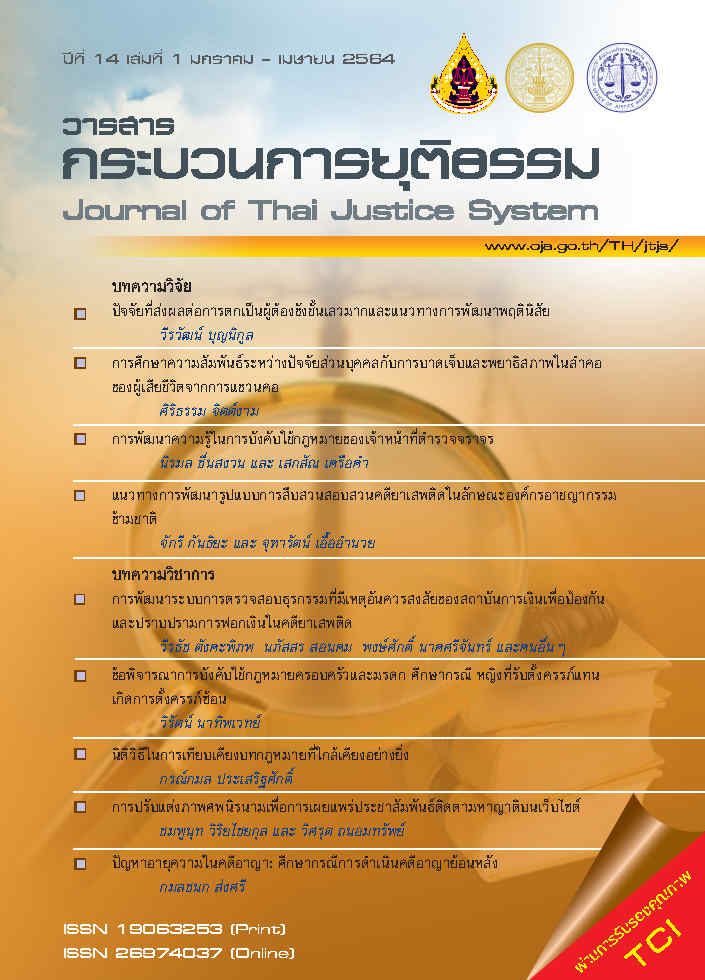ปัจจัยที่ส่งผลต่อการตกเป็นผู้ต้องขังชั้นเลวมากและแนวทางการพัฒนาพฤตินิสัย
Main Article Content
บทคัดย่อ
การวิจัยนี้มีวัตถุประสงค์เพื่อศึกษาลักษณะทางประชากรและพฤติกรรมการกระทำผิดของผู้ต้องขังชั้นเลวมาก เพื่อวิเคราะห์ปัจจัยที่ส่งผลต่อการถูกลดชั้นเป็นผู้ต้องขังชั้นเลวมาก และเพื่อศึกษาแนวทางในการพัฒนาพฤตินิสัยของผู้ต้องขังที่ตกเป็นผู้ต้องขังที่ชั้นเลวมาก โดยใช้วิธีการวิจัยแบบผสมผสานทั้งในเชิงปริมาณและเชิงคุณภาพโดยนำข้อมูลทุติยภูมิจากระบบฐานข้อมูลผู้ต้องขังที่จัดเก็บด้วยระบบคอมพิวเตอร์ การสัมภาษณ์เชิงลึกผู้ต้องขังชั้นเลวมากเพื่อจัดทำกรณีศึกษา จำนวน 15 คน และการจัดประชุมกลุ่มย่อยเจ้าหน้าที่ในเรือนจำ 3 แห่ง คือ ทัณฑสถานบำบัดพิเศษกลาง เรือนจำกลางบางขวาง และ เรือนจำกลางคลองเปรม ผลการศึกษาพบว่า การตกเป็นผู้ต้องชั้นเลวมาก แบ่งได้เป็น 3 ประเภท คือ 1.) ผู้ต้องขังกลุ่มที่กระทำผิดซ้ำเกิน 3 ครั้งขึ้นไป 2.) ผู้ต้องขังชั้นเลวมากที่เกิดจากการถูกลดชั้นจากการกระทำผิดวินัยเรือนจำ และ3.)ผู้ต้องขังกระทำผิดตามประกาศกระทรวงยุติธรรม เรื่อง กำหนดความผิดในคดีอุกฉกรรจ์คดีสะเทือนขวัญ หรือคดีที่เป็นที่สนใจของประชาชน พ.ศ.2563 ผลการศึกษา พบว่า ผู้ต้องขังชั้นเลวมาก ส่วนใหญ่เป็นชาย เป็นกลุ่มผู้ต้องขังที่กระทำผิดซ้ำเกิน 3 ครั้งขึ้นไป กระทำผิดในคดียาเสพติดมากที่สุด ส่วนใหญ่จบการศึกษาเพียงระดับประถมศึกษา รับจ้างทั่วไป ส่วนใหญ่กระทำผิดตั้งแต่อายุยังน้อย เกี่ยวข้องกับอบายมุขและถูกไล่ออกจากโรงเรียน มีพฤติกรรมต่อต้านสังคม (Antisocial) ปัจจัยที่ส่งผลต่อการตกเป็นผู้ต้องขังชั้นเลวมากพบว่า ปัจจัยด้านความผูกพันทางสังคม ปัจจัยด้านการถูกตีตราจากสังคม ปัจจัยด้านการเรียนรู้พฤติกรรมในเรือนจำมีส่วนทำให้ผู้ต้องขังตกเป็นผู้ต้องขังชั้นเลวมาก อย่างไรก็ตามจากการประชุมกลุ่มย่อยเจ้าหน้าที่ยังเห็นว่าคนกลุ่มนี้สามารถแก้ไขปรับเปลี่ยนพฤติกรรมได้แต่อาจต้องใช้ระยะเวลาและออกแบบโปรแกรมเฉพาะสำหรับผู้ต้องขังชั้นเลวมาก ซึ่งมีพฤติกรรมแตกต่างจากผู้ต้องขังกลุ่มอื่น
Article Details
ต้นฉบับที่ได้รับการตีพิมพ์ในวารสาร เป็นลิขสิทธิ์ของวารสารกระบวนการยุติธรรม แต่ความคิดเห็นที่ปรากฏในเนื้อหาของบทความในวารสารกระบวนการยุติธรรม ถือเป็นความรับผิดชอบของผู้เขียนแต่เพียงผู้เดียว
เอกสารอ้างอิง
กรมราชทัณฑ์. (2547). มาตรฐานการเลื่อนลดชั้นนักโทษ. กรุงเทพฯ: กระทรวงยุติธรม, กรมราชทัณฑ์, สำนักทัณฑปฏิบัติ. ผู้แต่ง.
กรมราชทัณฑ์. (2552). ระบบการจัดชั้นผู้ต้องขังในต่างประเทศ. กรุงเทพฯ: ผู้แต่ง.
กรมราชทัณฑ์. (2562). สถิติผู้ต้องราชทัณฑ์ทั่วประเทศจำแนกตามชั้นของนักโทษเด็ดขาด. กรุงเทพฯ: ผุ้แต่ง.
กรมราชทัณฑ์. (2563). สถิติการกระทำผิดซ้ำของผู้ต้องราชทัณฑ์. ค้นเมื่อ 1 พฤษภาคม 2563, จาก http://www.correct.go.th/recstats/index.php/th/Home
พรชัย ขันตีและคนอื่น ๆ . (2543). ทฤษฎี และงานวิจัยทางอาชญาวิทยา (พิมพ์ครั้งที่ 2). กรุงเทพฯ: บุ๊คเน็ท.
พระราชบัญญัติราชทัณฑ์ พ.ศ. 2560. 2560. ราชกิจจานุเบกษา, 173(3ก). 1.
เพลินใจ แต้เกษม. (2549). เบื้องหลังชีวิตของอาชญากรมืออาชีพ. กรุงเทพฯ: กรมราชทัณฑ์.
สำนักงานคณะกรรมการป้องกันและปราบปรามยาเสพติด. 2561. สถิติการจับกุมคดียาเสพติดทั่วประเทศเมื่อเปรียบเทียบระหว่าง พ.ศ. 2557-2561. กรุงเทพฯ: ผู้แต่ง.
วสันต์ สิงคเสลิต. (2543). การสร้างวินัยผู้ต้องขังด้วยระบบการตัดคะแนนความประพฤติ: กรณีศึกษาเรือนจำกลาง. อุดรธานี: โรงพิมพ์มหาวิทยาลัยรามคำแหง.


